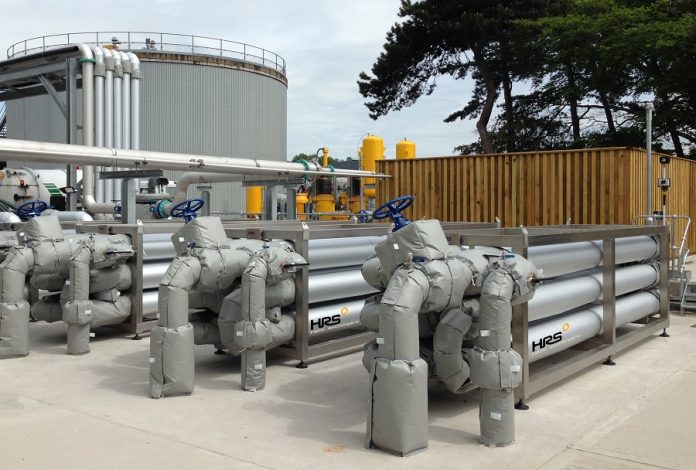By Matt Hale, International Sales & Marketing Director, HRS Heat Exchangers
Since the first spiral heat exchanger was proposed back in the 19th century, they have become synonymous with the treatment of slurries and wastewater; materials which have a high fouling risk, are viscous, or which contain fibres and solid materials. However, in many situations the performance of a corrugated tube heat exchanger is equal to or better than that of a spiral design. Not only that, but corrugated tube designs provide a number of additional advantages in terms of day-to-day operation and maintenance.
Proponents of spiral heat exchangers (sometimes known as shell and coil heat exchangers) cite the following advantages as making them suitable for handling challenging fluids:
- Good thermal performance, even where the temperature difference between the two materials is small;
- The spiral design and use of a single channel is claimed to prevent fouling and be ‘self cleaning’
- Compact design makes them suitable for installations where space and/or access is restricted;
- The counter-current flow provides an effective way to recover waste heat.
Based on such claims, it would seem that spiral heat exchangers are the ideal option for high-fouling wastewater and sludge situations. However, given how frequently clients choose to replace their existing spiral heat exchangers (SHEs) with corrugated tube units, some of these claims need closer inspection.
Thermal performance
There is no doubt that in theory SHEs offer greater thermal efficiency than conventional smooth surface tubular designs due to their large surface area and true counter-current flow. However, this assumes that the barrier between the product and service fluids is kept clean and operates efficiently at all times. In practice, fouling frequently occurs, interfering with thermal transfer. Where the heat exchanger is used for sludge-to-sludge applications, this fouling layer can create a double barrier to efficient heat transfer.
While these comparisons hold true for smooth tube heat exchangers, they do not always apply to corrugate tube heat exchangers. For example, like SHEs, the tube-in-tube HRS DTI Series is a true counter-current heat exchanger with the product flowing through the inner tube, and the service fluid flowing through the surrounding shell. The use of HRS corrugation technology increases heat transfer and operational efficiency, while also minimising fouling.
Non-fouling and ‘self cleaning’ designs
The design of SHEs can create turbulent flow inside the exchanger. In turn this is claimed to reduce the likelihood of fouling, and that where blockages do start to occur, product flow speeds up; creating a ‘scrubbing’ effect that dislodges the blockage (so-called ‘self cleaning’). This is fine in theory, but in our experience is unlikely in many real world situations, particularly where SHEs are used with sludge. In fact, when you read further into manufacturers’ brochures, ‘self cleaning’ often becomes ‘virtually no fouling and clogging’ – two very different claims.
Newer designs do not have the same support framework to separate the coils as some older models, as such structures were ideal at picking up rags and fibres from the sludge, leading to further blockages and a consequent reduction in heat exchange efficiency. As a result, manufacturers of SHEs also claim that their units are easy to clean. However, it is not uncommon to have to remove 40-50 bolts just to open the unit. Once opened, the construction means that the service fluid channel contains a large number of brackets which not only give the heat exchanger its rigidity, but make cleaning difficult in sludge-to-sludge situations. There is also the issue of the expensive bespoke gaskets which are used to seal SHEs, and which need to be replaced each time the cover is refitted.
Manufacturers of SHEs know that users don’t want to remove 50-odd bolts before they can clean the unit, (and have to do them all up to the correct torque again.) They also acknowledge that many materials, such as sewage sludge, require frequent cleaning. To overcome this they produce SHE models with hinged covers, which are held shut with C-clamps, so you don’t have to undo the bolts. While this type of design improves access, it increases the amount of space required for the installation and contradicts claims of SHEs being self-cleaning.
By contrast, the corrugated tubular design of the HRS DTI Series reduces fouling in a number of ways. The tube-in- tube design offers much larger channel than spirals, thereby reducing blockages. The corrugated inner tube also encourages turbulence, which increases heat transfer and reduces fouling – the very reason why HRS uses corrugated tubes. The tubes within the DTI Series are easy to clean and maintain. Removable bends make the tubes very easy to access, and there are no expensive gaskets to replace.
HRS has been asked by numerous clients to replace their existing SHEs because of significant problems with fouling, maintenance and repair; all of which lead to extended periods of downtime and overall poor performance.
Compact design
A hinged, clamped cover may make it easier to clean the supposedly self-cleaning SHE, but it also means that the cover has to have the room to open outwards. Finding room to accommodate this immediately increases the space required for an SHE installation.
It is also worth remembering that SHEs come in various shapes and designs and that many of the larger units are no more compact than other designs, such as those based on tubular heat exchangers.
Other benefits of corrugated double-tubes
While some of the benefits claimed for SHEs hold true when they are compared to smooth tubular heat exchangers, the benefits diminish when compared to corrugated tubes of the type used by HRS Heat Exchangers, in the DTI Series.
Unlike SHEs, the tubes can easily be removed for inspection, cleaning and maintenance and a variety of flange connections are available. The unit is also made in easy-to-replace sections. Should the heat exchanger suffer internal damage, the failed section can be easily bypassed by moving the interconnecting bends; a replacement can be manufactured and fitted when it is ready. In contrast, if a spiral is damaged, the complete heat exchanger must be removed to a workshop where many layers have to be cut out to access the point of failure. This is then re-welded and all the cut away sections must be re-welded into place. The cost is significant and downtime is many weeks.
Choosing the best solution
In many situations, we believe that a corrugated tube heat exchanger, like the HRS DTI Series, is the best solution for challenging materials such as sludge. However, in the most extreme cases with a very high fouling risk, it will be necessary to use a scraped-surface heat exchanger such as either the HRS rotating R Series or the patented reciprocating Unicus Series.
In order to select the best solution it is necessary to accurately assess the physical properties of the product or sludge to be treated, as well as the service fluid, inlet and outlet temperatures and the amount of heat regeneration required (if any). When comparing specifications or quotations for different solutions – for example SHEs compared to corrugated tubes – it is important to make sure that you are comparing like-for-like and that the performance specifications are identical. You should also assess whether any gains in efficiency or lower capital cost will be offset by increased fouling or operational costs over the full life of the unit.









